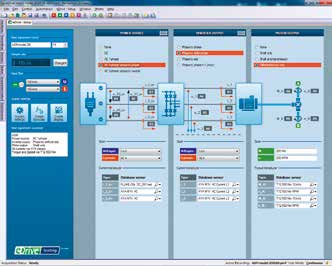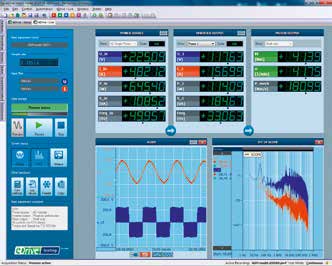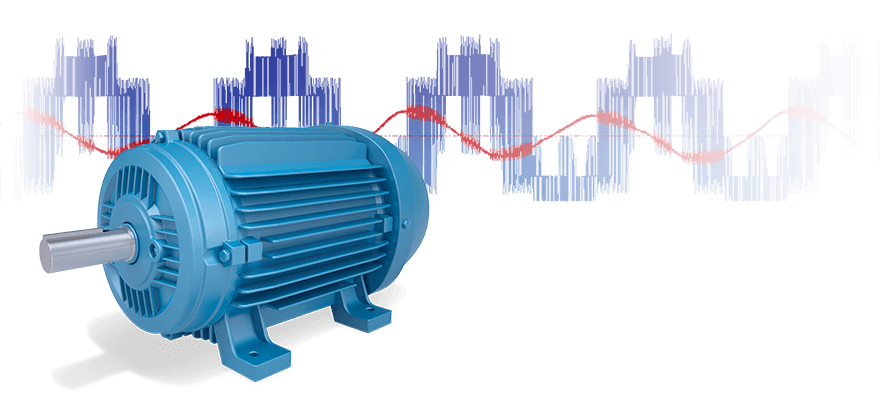The powerful eDrive Testing solution from HBM continuously saves, at high resolution, all the raw data relevant to increasing efficiency as well as electrical currents, voltage, torque, rotational speed, and even the engine temperature in a system. Another benefit: All important power values (effective, reactive, and apparent power, power factor, etc.) are displayed in real time as with a power meter.
What drives electrical machines and inverter?
The world is increasingly electrically powered. Electric drives affect our lives in a vast number of ways from washing machines to electric cars. Yet, manufacturers face a challenge - they must improve the overall efficiency of the electric motor, inverter and system. Standard methods used for performance testing and efficiency measurements provide results with limited reliability.
However, HBM’s innovative eDrive Testing solution is different; it combines a torque transducer, a power meter and a measurement data acquisition system, to allow both synchronous and dynamic recording of mechanical and electrical signals and real-time analysis.
A solid database is the foundation of any fundamental improvement in electric drives and the motors, inverters, and generators they power. Efficiency can be determined using a power meter, however, it cannot be explained. Nor can approaches toward increasing efficiency be derived from the data. What is needed is information that can be used to trace loss in efficiency unambiguously to its cause. New and innovative solutions to obtain that information are in demand.
Analyzing the causes of energy loss has been very diffcult
Power meters on the engine input and torque transducers on the engine output have traditionally been used to determine the energy conversion efficiency of electric motors and still are today. The difference between the measured electrical power and the mechanical output generated from it by the electric motor is the energy loss.
However, reliable conclusions regarding the causes of the lost energy cannot be drawn in this manner. In addition, measuring instruments, often from different manufacturers, must be tediously synchronized before each test. That takes precious time. But even more often, the process results in measurement errors. Highly dynamic power measurements with more than 50 measurements per second are difficult due to technical demands.
Another shortcoming of commercially available power meters is that they only return final results. But it is precisely the raw data that provides knowledge critical in fundamental research for understanding the processes involved, which in turn leads to productive approaches to boosting efficiency.
One simple integrated system is the solution
HBM has uncovered the solution, an efficient, integral system from a single provider: a combination of Genesis HighSpeed data acquisition and the T12HP torque transducer. The Power-Duo is perfectly coordinated, making it possible to perform long-term tests on electric drives, with exactly defined engine characteristic diagrams and without the burden of synchronizing. Continuous measurements lasting up to an hour with a maximum of one million measurements per second in each channel are a cakewalk as well as efficiency mapping with hundreds of one-off measurements at one-second intervals.
The resulting raw data is already available to developers for detailed analysis during the measurement. This serves as the basis for deriving valuable understanding to optimize the efficiency of electric drives. And this new system also represents HBM's response, in the form of advanced development, to users' requests for computing results such as current space vectors, d- and q-currents or air-gap moment.
As employees of the Polytechnical University of Turin working in the area of converters, electrical machines and drives, we chose the Gen3i from HBM as a data recorder and acquisition system for use in characterizing, identifying and monitoring power electronic inverters, electrical machines and drives. The decision was based on the fact that Gen3i is able to record and store both electrical quantities (PWM voltages and currents) and mechanical quantities (rotational speed, torque and position) and also because of its fast sample rates, high precision, exact synchronization taking into consideration delays in sensors, as well as electrical isolation. Gen3i thus combines the advantages offered by a power meter for acquiring data with those of a powerful data logger and analyzer, making it possible to post-process large data quantities measured on an electric drive.
Prof. Aldo Boglietti, Prof. Radu Bojoi, Prof. Paolo Guglielmi and Eng. Eric Armando, Polytechnical University of Turin
Analyze raw data live: view results immediately


The system's actual benefit becomes apparent during further analyses. Using powerful computing functions and a formula database, analyses can be performed directly in the measurement system while measurements are still running. Until now, this was only possible with separate mathematics packages. Analyses such as the determination of equivalent circuit diagrams or a dq0 transformation are just a few of the practically unlimited possibilities. The results are displayed immediately and can be transferred to an Excel spreadsheet, for example, simply by clicking a button.
This finally makes truly reliable and efficient drive analysis possible. Users benefit from enormous savings in time, flexibility, and a low error rate through measurements with an integrated system.
